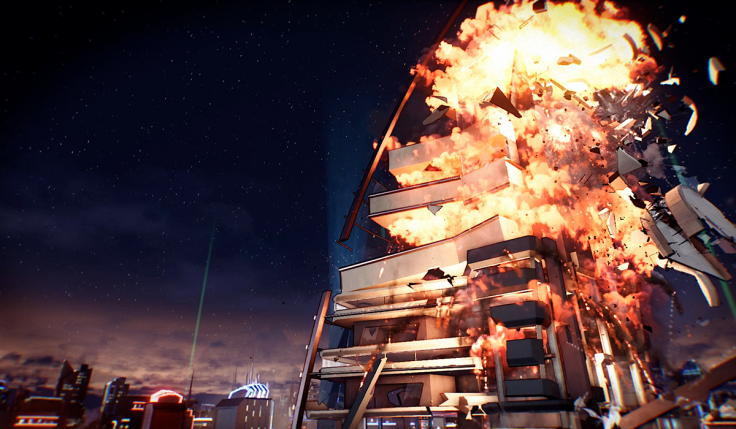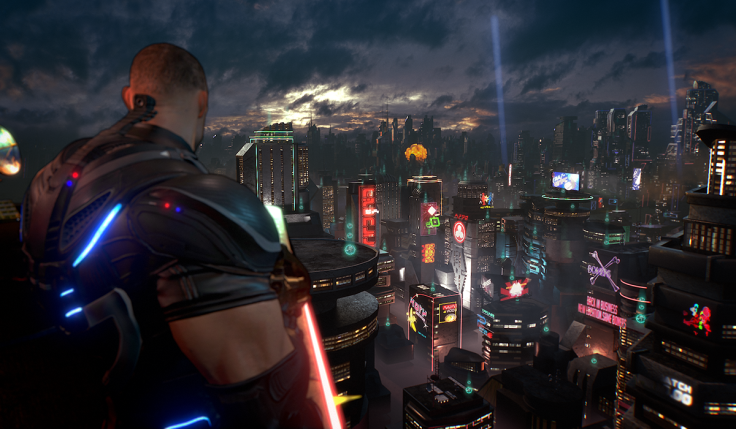Crackdown 3 Gamescom hands-on preview: Xbox One takes series to cloud nine (or fourteen)

For, years 'the cloud' has been touted as the next revolutionary thing, when really it's just the internet. Your photos aren't stored on a mythical techno cloud – they're stored on someone else's server that you can access through the web. 'The cloud' as a marketing term has been around for a while, making many audiences groan whenever it's mentioned. At Gamescom 2015, however, during a demo of long-awaited Xbox One sequel Crackdown 3, I was blown away by the applications of it for the first time.
At its press conference for the event, Microsoft showed off the game in action (see the video below) and its multiplayer section, which uses cloud servers to render the map's many buildings fully destructible. This total destruction is limited to a separate multiplayer mode; the campaign itself – which can be played co-op with four players – will not feature destructible buildings in the same way.
Let's begin with that campaign. It is structured exactly the same as the celebrated original, with your Agency enforcer tasked with taking out warlords who have an entirely new city in their grip. There are orbs, of course, the same five abilities to power up (strength, firearms, driving, agility and explosives) and a transforming Agency super-vehicle. The map is also roughly the same size as the original, only with a greater sense of height, we're told.
There are some changes, however. Firstly, developer Reagent Games – led by the original game's director Dave Jones – is looking to expand the roles of the warlords by making them more fully realised characters, with personalities rather than mere targets.

During a behind-closed-doors demo, Jones was eager to point out that the team didn't want any additional narrative to alter the flow of play – so Crackdown 3 uses the "digital fabric" of its environment to allow warlords to speak directly to you. This means they can appear on billboards or as massive holographic heads, such were the two examples we saw. A new "hate meter" will also play into how gamers draw out and take down these warlords. The more of their foot soldiers you dispatch, the more strongholds you take back from them and more destruction you cause, the more the warlord will hate you until eventually they snap and decide to take you on.
The warlord in our demo was far more of the bastard, though. Donning a large mech suit, he didn't go after the player, but civilians – making a point of taking innocent lives to get to the Agency he despises. The mech itself requires different tactics to dispatch. Bullet fire isn't effective, so players must use grenades, rocket launchers and the environment. Following the demo, we were shown and then allowed to get to grips with a small and simple destruction sandbox area showing off the separate multiplayer portion. This basic set-up didn't include climbing: this was purely to show off the physics and how far beyond the Xbox One's capabilities the destruction stretches.
Immediately in front of the player were two towers. Equipped with three weapons – naturally, we went with the grenade launcher – we slowly blew chunks out of the buildings, watching each piece of the tower crumble and fall away. Rather than evaporating when they hit the ground, pieces of rubble then become physical objects in the environment, and can even be thrown if your strength is high enough.
In the corner of the screen was a series of bars that filled up as the destruction escalated. The first bar shows the computing power of the Microsoft console, and it fills up quickly. Underneath this were a second and third bar – the first representing cloud servers being used, of equal power to the console. A coloured overlay of the environment showed that the two buildings in front of us were being handled by the two different servers, with further ones coming in when needed.
As these two buildings crashed to the ground, the bars filled up, and then a fourth bar (a third server) popped up – then a fifth and a sixth. As the towers collapsed – none of it scripted; everything being handled by the physics engine – the bars filled and more appeared. I asked Jones how far this goes, and he said the most servers they've managed so far during the show was fourteen. In our demo we managed 12, and it induced no slowdown.
The game's website states that the cloud offers Crackdown 3 some 20 times the power of an Xbox One, indicating that 20 servers is the maximum per game.
The manner of the destruction also opened up methods of play. A collapsed building can be climbed, it can be brought down with players and enemies on or in them, and it can create ramps. Buildings can also take out other, smaller buildings, should they fall that way.
Gameplay implications were clear, but initially shallow. Reagent will have to be inventive to make full use of the impressive tech on display. As for the feel of the game, fans will be pleased to hear that combat and movement are handled in the same manner as the original. So the campaign will be familiar, and looks set to bring with it all the same joys – but in the multiplayer arena, Reagent have something with massive potential.
Crackdown 3 is set for release in summer 2016.
For all the latest video game news follow us on Twitter @IBTGamesUK.
© Copyright IBTimes 2024. All rights reserved.







